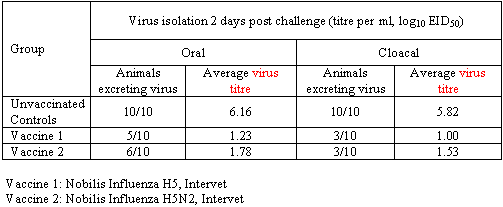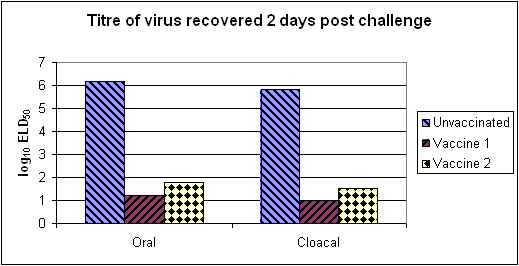



Avian Influenza in South East Asia, is there a Solution?
By J.H. Breytenbach, Intervet International b.v. - Since mid-December 2003 highly pathogenic avian influenza (HPAI) has caused havoc in the Asian poultry sector. To date a total of nine countries have reported HPAI cases in what is the largest outbreak of the disease ever recorded. In addition human fatalities in Vietnam and Thailand catapulted avian influenza into the public arena on fears of a possible global influenza pandemic should the virus start spreading from human to human.
Introduction
The biggest concern is nine months after the first HPAI cases we continue to see reports of new outbreaks; this despite the large scale culling of poultry in an attempt to stamp out the disease. For how much longer will governments be able to sustain a policy of culling poultry flocks and compensating farmers? Have all the available control methods been exhausted?
Control Options
HPAI is classified as a List A disease by the Office International des Epizooties (OIE). Per definition List A diseases are transmissible diseases which have the potential for very serious and rapid spread, irrespective of national borders, which are of serious socio-economic or public health consequence and which are of major importance in the international trade of animals and animal products. Hence a stamping out policy is the preferred method of control for HPAI with the objective of returning a country to a disease free status in the shortest possible time. This becomes particularly critical to countries with large export markets.
Stamping out a highly infectious disease relying only on the culling of infected animals and possible contact animals may not always be the most effective method. This is particularly relevant for poultry where often there are high density pockets of poultry favouring the rapid spread of disease. Vaccination is an additional tool which if used in tandem with selective culling could effectively stop the spread of the disease and improve the chances for eradication.
A misconception however exists that the OIE does not make provision for vaccination in the control of HPAI. According to Article 2.1.14.2. of the OIE document 'International Animal Health Code - 2003' a country is defined free of HPAI 'six months after the slaughter of the last affected animal for countries in which a stamping out policy is practiced with or without vaccination.' This clause thus confirms the primary objective to stamp out HPAI, but at the same time acknowledges that vaccination may have a role to play in the process.
Strict Stamping Out, No vaccination
Eradication of HPAI by a strict stamping out policy and no vaccination has successfully been achieved in the past, one recent example being the 2003 HPAI outbreak in The Netherlands. During a period of two-and-a-half months the virus spread from an initial outbreak involving six poultry farms to a total of 255 confirmed cases, despite strict control measures on bird movement. In total 30.7 million birds were culled at a direct cost of EUR 270 million.
Stamping out a disease is a very intensive operation involving high costs. The success of a stamping out strategy relies on a number of factors. Firstly a sound national veterinary infrastructure is required for rapid diagnosis and extensive monitoring. Secondly a high level of transparency and co-operation is required between national authorities and farmers. Further to this the higher the ratio of informal small scale poultry farmers in a disease area the more difficult the task of implementing strict control measures. In the Dutch case control by stamping out in a relatively short period of time was only possible due to the swift action of authorities, veterinary services and farmers in a well structured and tightly controlled poultry industry.
Challenges facing Asia
Asia has one of the most dynamic poultry sectors, experiencing significant growth over the past decade. However, with rapid growth there is often a price to pay. The relatively low entry threshold for poultry farming has seen highly modernized integrated farming operations developing side by side to a booming small informal sector. Further to this poultry in Asia is not limited to chickens, but also includes a thriving duck and goose sector. A large proportion of poultry reaches the consumer via live bird markets adding yet another angle to the dynamics of the industry.
All of the above factors resulted in a time bomb and HPAI (H5N1) was the catalyst to set it ticking. Major poultry growth occurs on the periphery of mega cities, resulting in high density poultry pockets that resemble large multi age farms, often with a poor level of on farm biosecurity. This favours the rapid spread of infectious diseases, further amplified by a trade in live birds. Ducks and geese reared in close proximity to chickens present an additional risk. Ducks and geese are relatively resistant to the negative effects of avian influenza viruses, however they shed virus in their faeces contaminating pond water and the immediate environment.
There is no plausible explanation yet for the rapid spread of the H5N1 HPAI virus across Asia, though theories do exist that migratory birds, especially wild ducks and geese, may have had a role to play. Continued re-infection of flocks suggests that the virus may now be endemic to the region.
Pressure is mounting on the poultry industry and governments to rid the region of this scourge in the interest of public safety. Since January 2004 there have been 40 confirmed cases of avian influenza infecting people in Vietnam and Thailand. 29 of these cases were fatal. As long as the H5N1 avian influenza virus continues to circulate in poultry populations the risk of human infection remains and with that a far greater concern, the possibility that a new virus subtype with pandemic potential could emerge for which there is no vaccine to confer protection in humans.
Vaccination as an Additional Control Option
The most commonly used AI vaccines are inactivated viral vaccines in a mineral oil adjuvant. Vaccinated birds are far more resistant to infection and if birds do become infected they shed significantly less virus, a reduction of up to 10,000 times (Refer Table 1). The net result is less virus shed into the environment, reducing the risk of viral transmission to other poultry flocks and wild birds, and most importantly reducing the risk of virus transmission to humans. The exact conditions for human infection are not clear, but it would appear that human infections mostly occur in situations of high exposure to virus.
Would a decision to start vaccinating be a point of no return? Not necessarily, there are examples among others in the USA and Italy where vaccination was successfully used as part of an eradication scheme. Once the virus was eradicated from the control area vaccination was stopped and as inactivated vaccines are used there is no concern about circulating live vaccine strains.
It is however essential to realize that inactivated vaccines have certain limitations and do not replace strict controls on bird movement, monitoring for virus circulation and culling of infected flocks. The most practical method to monitor for viral circulation in vaccinated flocks is to leave a number of birds unvaccinated on each farm, so called sentinel birds. Should there be high mortality among these sentinels further investigation is required to determine the cause of death. To declare flocks free of infection the original sentinel birds must test negative for avian influenza.
Hong Kong took the lead in controlling H5N1 avian influenza in Asia when they introduced vaccination as part of their control strategy in 2002/2003. In a recent publication Ellis, et. al1 reported two cases were an H5 vaccine effectively interrupted virus transmission in a field setting. Following intensive monitoring by virus culture on the affected farms the authors concluded that vaccination had not only stopped virus transmission, but that there was also no evidence of any asymptomatic shedding of the virus from the remaining chickens.
1 Ellis, T.M., Leung, C.Y.H.C., Chow, M.K.W., Bissett, L.A., Wong, W., Guan, Y. and Malik Peiris, J.S. (2004). Vaccination of chickens against H5N1 avian influenza in the face of an outbreak interrupts virus transmission. Avian Pathology 33:405-412
Other control measures implemented in Hong Kong include intensive monitoring on farms and at live bird markets, separate markets for ducks and geese and regular bird free rest days in markets. As a result of these strict control measures and a vaccination policy Hong Kong has not been affected by the recent avian influenza outbreak.
China too has been effective in controlling the impact of HPAI during the recent HPAI outbreak using a combination of vaccination, culling of infected poultry and strict controls on the movement of poultry.
Conclusion
Considering the diversity of the Asian poultry industry and the unique poultry husbandry practices and marketing channels in the different countries there is no fixed recommendation that will fit all. The solution is probably found in a balanced approach including improved biosecurity on farms, modernizing poultry operations in high density areas, segregating ducks and geese from chickens and vaccinating poultry in high risk areas. Most importantly though many Asian countries need assistance and investment to develop a veterinary infrastructure better able to cope with the demands of controlling an epizootic of this proportion.
 Table 1. Response of chickens vaccinated at 3 weeks of age with two commercial H5 inactivated AI vaccines and challenged intranasally 3 weeks post vaccination with a recent HPAI H5N1 isolate from Asia (2003). (Dr D.E. Swayne, Laboratory Director Southeast Poultry Research Laboratory, USDA/ARS, Athens Georgia) |
 Graph 1. Graphic representation of the titre of the virus isolated post challenge as tabulated in Table 1. |
Source: Intervet International b.v. - May 2005









